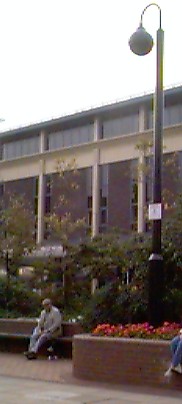
Trial clippings : Wakefield Gazette
|
Dixon Hall footage 1; Rachel & Hughes |
Dixon Hall 2; heading along Doncaster Rd |
|
Dixon Hall 3; Hughes returns alone. |
The Dixon Hall security camera. |
As killer Stephen Hughes begins his life sentence for the brutal murder of Bradford teenager Rachel Barraclough, attention has been rightly focussed on the role that Wakefield's city centre CCTV system played in his conviction. Certainly CCTV footage taken on that fateful September night last year proved crucial in helping police break Hughes alibi claims. The case has become one of the few success stories of CCTV.
Yet although Rachel's last walk across Wakefield city centre was apparently captured on 5 of the city's new state-of-the-art cameras, it was footage from a private, fixed surveillance camera that proved the most crucial. It was this piece which showed Hughes and Rachel leaving the centre and heading out towards the spot where she met her death. 2 hours later the same camera recorded Hughes returning alone. The jury at Hughes trial asked to view this clip again, before returning their guilty verdict.
And although it's not possible to identify Hughes directly from the hazy images, police were able to use the footage to help them piece together Rachel's last movements and convince Hughes to finally admit that he was the shadowy figure seen with Rachel.
It was a phone call on Friday, September 6th last year which made Rachel change her plans and set off to Wakefield. She believed she was going to meet her estranged boyfriend Carl Hughes.
CCTV cameras at Bradford Interchange caught Rachel clearly cutting across the bus station shortly after 8 pm. She passed the stop from where the Wakefield bus left and withdrew £40 from a mini-bank before leaving the Interchange. Police believe she subsequently caught the 423 bus which left at 8.22 pm.
Meanwhile at Wakefield bus station, Carl and his father Stephen were waiting for Rachel. They had been drinking all afternoon. When she didn't arrive as expected, Carl's father offered to wait and see if she got off the next bus, and said he would bring Rachel to the Rainbow pub. He sent Carl home to get changed.
Stephen Hughes later told police that Rachel never arrived, and that he left alone and went on a solo pub crawl before heading home sometime after 11 pm.
When Rachel's body was found the following day and identified, police began to piece together her movements on the fatal night.
Carl soon became the prime suspect, especially when a blood stained T-shirt of his was found at his home (the blood turned out to be his own). He was known to have a violent temper and had beaten Rachel the week before.
As he was to subsequently tell the jury at Leeds Crown Court,
"The police thought it was me. For three weeks they interviewed me. But I had an alibi. Then when they proved it weren't me, they went off me and went on to my dad."
As Carl was being questioned, police began to gather and study CCTV footage from the councils newly installed city centre CCTV system and other private surveillance cameras.
The new £400,000 high tech system had been switched on less than a month earlier. 36 cameras, hidden in large black globes, cover all the city centre. A brand new state-of-the-art control centre at Chantry House records all the images, and pictures are automatically relayed to the Area Communications Room at Wakefield Police Station.
Superintendent John Holt, leading the inquiry, set four officers the task of checking each piece of footage frame by frame. They worked 10-12 hour shifts over seven days. A police spokesman told KDIS that eventually they identified 16 pieces of footage pertinent to the inquiry, including pieces showing Carl Hughes movements that night, thus helping to confirm his alibi.

5 pieces included images of Rachel on her last fateful walk through Wakefield. She was caught by a camera in the Bull Ring shortly after getting off the bus at 9.17 pm. But the clearest pictures came from a fixed private camera on the premises of Dixon Hall ironmongers on the Doncaster road leaving the centre. The images show a man and a woman, subsequently identified as Rachel and Stephen Hughes, passing at 9.27 pm. The man is then seen returning alone 2 hours later at 11.24 pm.
Although police were unable to directly identify Stephen Hughes from the pictures, they were able to put this together with all the other evidence they had, using what a police spokesman described as "normal investigative methods", and became convinced that Stephen Hughes had been lying when he said Rachel never turned up.
Hughes was arrested on Wednesday 17 September, just 12 days after Rachel's body had been found. Although there was no forensic evidence linking him with the killing, he was formally charged with murder 2 days later.
He continued to deny that he had seen Rachel that night. But police were now able to build up a convincing picture of peoples movements. They told him that they had incontrovertible CCTV evidence that he had indeed met Rachel off the bus and walked with her towards the murder spot.
Eventually, 6 months after his arrest, Hughes changed his story. He now acknowledged that he had indeed met her off the bus. He claimed that he had walked her to the Superbowl and left her there unharmed. But his admission only strengthened the CCTV evidence. It served to highlight his previous lies, both to the police and to his own family. The footage now provided a chilling account of his movements with Rachel in the last moments of her life.
Just like the famous Jamie Bulger video, the power in the images lay not in their direct evidential value, but in their emotional impact. It is not difficult to imagine the force that those images must have had on the jury when they asked to see them again at the end of the trial.
Trial clippings : Wakefield Gazette : Main CCTV article : KDIS Online